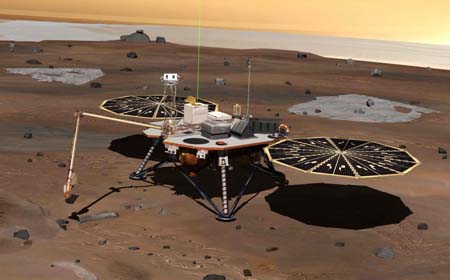
In this artist's illustration obtained from NASA on May 23, NASA's Phoenix Mars Lander is seen on the surface of Mars after landing. After traveling for almost 10 months, Mars Phoenix Lander successfully landed on the Red Planet Sunday on a mission to explore signs of life, according to NASA's Jet Propulsion Laboratory (JPL). (Xinhua Photo)
US Phoenix lander's arm movement and other activities scheduled on its second day on Mars are delayed because NASA's Mars Reconnaissance Orbiter flying over mars failed to relay commands from the Earth, the US space agency reported Tuesday.
NASA engineers sent commands for moving the lander's robotic arm on Tuesday morning, to the orbiter for relay to Phoenix. However, the orbiter did not relay those commands to the lander due to a glitch, said NASA's mission updates.
Now, the Phoenix team has decided to delay the arm movement into Wednesday. It will try to move its crucial arm, unlatch its wrist and then flex its elbow for the first time after the successful landing on Sunday.
The Mars orbiter's communication-relay system is in a standby mode. NASA's another orbiter, Mars Odyssey, is available for relaying communications between Earth and Phoenix.
Mission scientists are eager to move Phoenix's arm, for that arm will deliver samples of icy terrain to their instruments made to study this unexplored Martian environment.
During the next three months, the arm will dig into soil near the lander and deliver samples of soil and ice to laboratory instruments on the lander deck.
(Xinhua News Agency May 28, 2008)